|
First Impressions
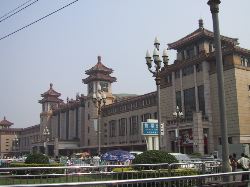 I arrived in Beijing around noon after a short flight from Wuhan.
Although I have been to eight provincial capitals and many country towns
through various trips to China, this is my first visit to the national
capital. I try not to spend too much time in national capitals because I
wouldn't want America to be judged solely by Washington or New York or
even Chicago. My first impression of Beijing is that it is a proper
capital city. The expressway leading from the airport is completely lined
with trees until you reach about the fourth or fifth ring road where you
are greeted with embassies, international hotels, and countless office
buildings. I thought some of the other Chinese cities felt big, but this
place is definitely too big for pedestrians. So, like any self-respecting
capital, they have a proper subway system that costs about 0.40USD per
ride to go around the second ring. Because of tao or zen or something,
most of the mainland cities seem to be built on simple north-south grids
which have been surrounded by these square ring road. Most cities have
only three or four rings but Beijing has six or eight, depending on how
you count.
I arrived in Beijing around noon after a short flight from Wuhan.
Although I have been to eight provincial capitals and many country towns
through various trips to China, this is my first visit to the national
capital. I try not to spend too much time in national capitals because I
wouldn't want America to be judged solely by Washington or New York or
even Chicago. My first impression of Beijing is that it is a proper
capital city. The expressway leading from the airport is completely lined
with trees until you reach about the fourth or fifth ring road where you
are greeted with embassies, international hotels, and countless office
buildings. I thought some of the other Chinese cities felt big, but this
place is definitely too big for pedestrians. So, like any self-respecting
capital, they have a proper subway system that costs about 0.40USD per
ride to go around the second ring. Because of tao or zen or something,
most of the mainland cities seem to be built on simple north-south grids
which have been surrounded by these square ring road. Most cities have
only three or four rings but Beijing has six or eight, depending on how
you count.
Biking the Backstreets
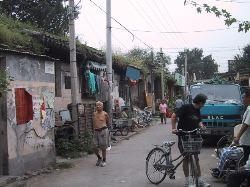 After wandering around for a bit, I found a single room in a hostel
(15USD?) and rented a bike for the rest of the afternoon (2.50USD?). The
price was a bit high this time, but I got a proper city bike made by Giant
with a rear rack which came in handy. I road passed some of the big sites
and headed for some of the backstreets of the inner city. Typically, just
one block in from the high street the appearance changes completely. Old,
one-story brick buildings are falling apart on top of the residents. The
locals seem happy to walk or cycle over the rubble as they go about their
daily lives.
After wandering around for a bit, I found a single room in a hostel
(15USD?) and rented a bike for the rest of the afternoon (2.50USD?). The
price was a bit high this time, but I got a proper city bike made by Giant
with a rear rack which came in handy. I road passed some of the big sites
and headed for some of the backstreets of the inner city. Typically, just
one block in from the high street the appearance changes completely. Old,
one-story brick buildings are falling apart on top of the residents. The
locals seem happy to walk or cycle over the rubble as they go about their
daily lives.
2008 Makeover
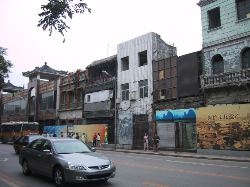
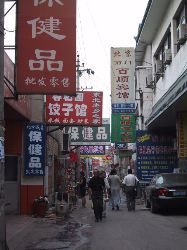 I thought that the Three Gorges Dam project could not be matched, but here
in Beijing, the government has taken-on yet another project of grand scale
which causes thousands of residents and shopkeepers to be displaced
(temporarily?). An old shopping street that leads south from Tiananmen
Square seems slated for a complete rebuild in-time for the 2008 Olympics.
The street used to be lined with two-storey shops of all styles and
colors, but everything is boarded-up now and the wall shows an idylic
image of a proper "Chinese" shopping district filled with shoppers from
around the world. They are trying to make it look like Beijing might have
looked 100 years ago if ever there were a period of peace and prosperity.
But if the entire area is rebuilt in one huge project, I can't see how the
finished product will look much different from other suburban projects
that spring-up overnight in other countries. Again I walked a few blocks
into the alleyways to see how far this rehab project was going. I found
that the parallel street to the west is lined with "adult" shops and cheap
hotels. Perhaps the city wants to do a bit more than a facelift.
I thought that the Three Gorges Dam project could not be matched, but here
in Beijing, the government has taken-on yet another project of grand scale
which causes thousands of residents and shopkeepers to be displaced
(temporarily?). An old shopping street that leads south from Tiananmen
Square seems slated for a complete rebuild in-time for the 2008 Olympics.
The street used to be lined with two-storey shops of all styles and
colors, but everything is boarded-up now and the wall shows an idylic
image of a proper "Chinese" shopping district filled with shoppers from
around the world. They are trying to make it look like Beijing might have
looked 100 years ago if ever there were a period of peace and prosperity.
But if the entire area is rebuilt in one huge project, I can't see how the
finished product will look much different from other suburban projects
that spring-up overnight in other countries. Again I walked a few blocks
into the alleyways to see how far this rehab project was going. I found
that the parallel street to the west is lined with "adult" shops and cheap
hotels. Perhaps the city wants to do a bit more than a facelift.
Tiananmen Square, Forbidden City, Temple of Heaven
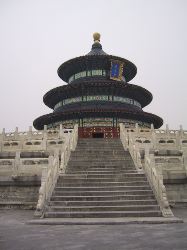 Honestly, my time in China was limited, so I just skipped the Forbidden
City this time. Since the old palace has almost 1000 buildings, it seemed
like a bit much for a half-day visit. Not content with the largest palace
in the world, the Chinese also built the world's largest public square.
Since it has no trees and no benches, I didn't find it too inviting.
Although it is a public space in a country that loves "community" the
government still seems to control this space. One place I kinda liked was
the Temple of Heaven in a huge park south of the train station. This park
actually has trees (in perfect rows), but I think I just liked it because
it reminded me of the round China pavilion at Epcot in Walt Disney World!
Honestly, my time in China was limited, so I just skipped the Forbidden
City this time. Since the old palace has almost 1000 buildings, it seemed
like a bit much for a half-day visit. Not content with the largest palace
in the world, the Chinese also built the world's largest public square.
Since it has no trees and no benches, I didn't find it too inviting.
Although it is a public space in a country that loves "community" the
government still seems to control this space. One place I kinda liked was
the Temple of Heaven in a huge park south of the train station. This park
actually has trees (in perfect rows), but I think I just liked it because
it reminded me of the round China pavilion at Epcot in Walt Disney World!
Nightlife
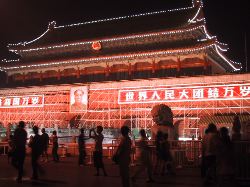 Generally the nightlife is the same in every city if you can just find the
right club. Out of curiosity, I decided to see what Beijing had to offer
on a Monday night. I had some extra cash in my pocket because the Chinese
pizza place (Origus) that I tried to eat at closed early (9:30pm), so I
headed for the Worker's Stadium on the east side of town. This area,
known as Chaoyang, is home to most of the embassies, foreign businesses,
and ... bars. I skipped the China Lounge and went for Coco Banana. This
place was packed with 19-year-old Chinese people trying their best to look
like all the movies they have seen. The bartenders were doing all the
tricks they learned from Tom Cruise in Cocktail including every color and
alcohol and every flaming drink I have ever heard of. This is the problem
with Hollywood. In America we just laugh at all the silly things on tv or
in film, but in developing countries, they think this is real and the
emulate it to the T. Sometimes this is not a bad thing, but surely these
kids have something better to do with their time and money on a Monday
night. The new wealth of China is a little scary.
Generally the nightlife is the same in every city if you can just find the
right club. Out of curiosity, I decided to see what Beijing had to offer
on a Monday night. I had some extra cash in my pocket because the Chinese
pizza place (Origus) that I tried to eat at closed early (9:30pm), so I
headed for the Worker's Stadium on the east side of town. This area,
known as Chaoyang, is home to most of the embassies, foreign businesses,
and ... bars. I skipped the China Lounge and went for Coco Banana. This
place was packed with 19-year-old Chinese people trying their best to look
like all the movies they have seen. The bartenders were doing all the
tricks they learned from Tom Cruise in Cocktail including every color and
alcohol and every flaming drink I have ever heard of. This is the problem
with Hollywood. In America we just laugh at all the silly things on tv or
in film, but in developing countries, they think this is real and the
emulate it to the T. Sometimes this is not a bad thing, but surely these
kids have something better to do with their time and money on a Monday
night. The new wealth of China is a little scary.
Weather and Smog
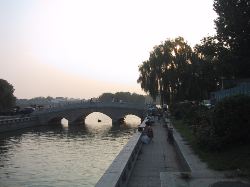 One thing all this progress has brought is smog. Throughout two months of
travelling, it has been sunny and hot almost every day. But as soon as I
got to China, I was happy to find overcast weather. It took me a day or
two to realize that this is not due to clouds, it is the smog! Granted,
there seems to be a lot of fog in the mountains, but I have only seen the
sun a few times in my two weeks in China. Still, the heat of the sun gets
through. I visited two of the "Four Furnace" cities of China, but I made
a point of only staying in each a few hours. By spending time in the
mountains, on the river, and under the trees, China has been pretty
comfortable. Actually, Beijing has been one of the few places where I
could see the sun a bit. I decided to make one last trip to the mountains
before leaving China.
One thing all this progress has brought is smog. Throughout two months of
travelling, it has been sunny and hot almost every day. But as soon as I
got to China, I was happy to find overcast weather. It took me a day or
two to realize that this is not due to clouds, it is the smog! Granted,
there seems to be a lot of fog in the mountains, but I have only seen the
sun a few times in my two weeks in China. Still, the heat of the sun gets
through. I visited two of the "Four Furnace" cities of China, but I made
a point of only staying in each a few hours. By spending time in the
mountains, on the river, and under the trees, China has been pretty
comfortable. Actually, Beijing has been one of the few places where I
could see the sun a bit. I decided to make one last trip to the mountains
before leaving China.
Great Wall
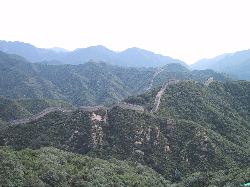 A few sections of the wall are not far from downtown, but they are in some
pretty rugged mountains. I took a city bus out and paid my admission to
walk the wall with thousands of other people at Badaling. Many of the
backpacker guidebook encourage you to hike one of the quieter sections of
the wall which have not been refurbished for tourists, but I was quite
content with Badaling. It is nice to see how it looked back in its
hey-day- very impressive indeed. Still, there are a few myths about the
wall that I would like to dispel here. 1. It was never a contiguous wall
stretching across the entire northern border. 2. It is not visible from
space (the Chinese confirmed this themselves in 2003). 3. It was never
really effective at deterring many enemies. The main enemy from the north
supposedly just bribed the guards to get through while all of the other
invades from Europe and Japan arrived by sea on the east coast. Still,
the wall is definitely worth a visit if you are in the area.
A few sections of the wall are not far from downtown, but they are in some
pretty rugged mountains. I took a city bus out and paid my admission to
walk the wall with thousands of other people at Badaling. Many of the
backpacker guidebook encourage you to hike one of the quieter sections of
the wall which have not been refurbished for tourists, but I was quite
content with Badaling. It is nice to see how it looked back in its
hey-day- very impressive indeed. Still, there are a few myths about the
wall that I would like to dispel here. 1. It was never a contiguous wall
stretching across the entire northern border. 2. It is not visible from
space (the Chinese confirmed this themselves in 2003). 3. It was never
really effective at deterring many enemies. The main enemy from the north
supposedly just bribed the guards to get through while all of the other
invades from Europe and Japan arrived by sea on the east coast. Still,
the wall is definitely worth a visit if you are in the area.
--By the Way--
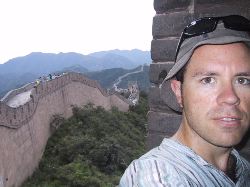 The internet is a priceless tool for the modern solo traveller, and as you
can guess a spent a few hours in front of computers while in China.
Luckily, China has more internt cafes than any country I have seen yet.
They rarely actually say "internet" on the sign, but if you can read the
Chinese characters, you will see tons of these shops all over. Inside,
there are few people typing email or browsing traditional websites. Many
people are doing role-playing games or dancing on a virtual stage with
other internet denizens. Others are using cameras and mikes to do video
chat with singles they met online. Others are watching tv or pirated
movies. One shop is often made-up of many rooms each full of over fifty
people playing around on state-of-the-art computers 24 hours a day for
only 0.25USD per hour. It is all quite high-tech, but unfortunately two
of my favorite websites (BBC News and Wikipedia) are banned in China!
Evidently domestic mobile phones (even in the countryside people have the
most expensive Motorolas and Nokias!) are not allowed to receive text
messages from abroad either. It seems what Chinese people need is not
access to computers and technology, but maybe just a bit more access to
free information...
The internet is a priceless tool for the modern solo traveller, and as you
can guess a spent a few hours in front of computers while in China.
Luckily, China has more internt cafes than any country I have seen yet.
They rarely actually say "internet" on the sign, but if you can read the
Chinese characters, you will see tons of these shops all over. Inside,
there are few people typing email or browsing traditional websites. Many
people are doing role-playing games or dancing on a virtual stage with
other internet denizens. Others are using cameras and mikes to do video
chat with singles they met online. Others are watching tv or pirated
movies. One shop is often made-up of many rooms each full of over fifty
people playing around on state-of-the-art computers 24 hours a day for
only 0.25USD per hour. It is all quite high-tech, but unfortunately two
of my favorite websites (BBC News and Wikipedia) are banned in China!
Evidently domestic mobile phones (even in the countryside people have the
most expensive Motorolas and Nokias!) are not allowed to receive text
messages from abroad either. It seems what Chinese people need is not
access to computers and technology, but maybe just a bit more access to
free information...
Aaron Bishop
30 August 2006
|








